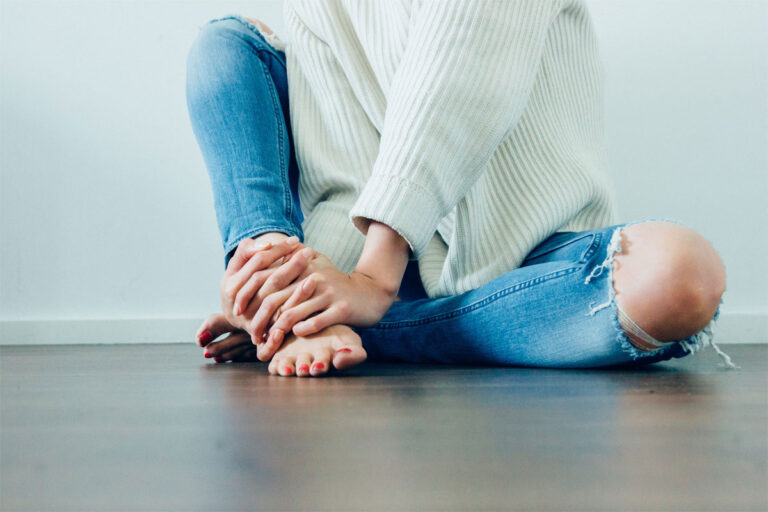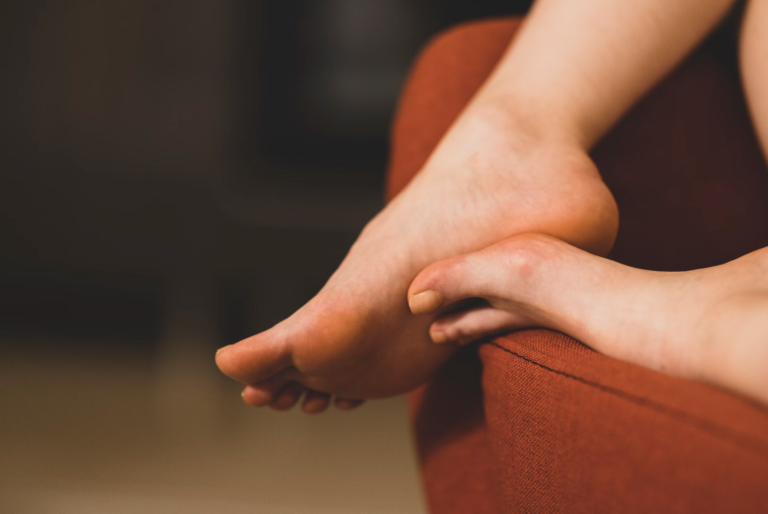Women with Flat Feet – Causes, Symptoms, and Solutions
Did you know that a staggering 30% of women in the United States have flat feet, a common condition that can lead to a range of foot-related issues? Flat feet, also known as pes planus, is a prevalent condition that affects the structure and function of the foot. While it can occur in both men and women, research suggests that women are more prone to developing flat feet due to various physiological and biomechanical factors. In this article, we will explore the causes, symptoms, and effective solutions for women with flat feet, ensuring they can find the right support and relief.

Key Takeaways
- Flat feet are a common condition that affects the structure and function of the foot, impacting up to 30% of women in the United States.
- Women are more prone to developing flat feet due to factors such as pregnancy, obesity, and age-related changes.
- Symptoms of flat feet can include physical signs, pain, discomfort, and mobility limitations.
- Non-surgical treatments, such as orthotic devices, supportive footwear, and physical therapy, can be effective in managing flat feet.
- Maintaining a healthy weight, wearing proper footwear, and performing foot-strengthening exercises can help prevent or manage the development of flat feet in women.
Understanding Flat Feet in Women
To fully comprehend the challenges faced by women with flat feet, we must first explore the intricate anatomy of the human foot. The foot is a remarkable structure, composed of 26 bones, 33 joints, and a complex web of muscles, tendons, and ligaments that work together to support our body’s weight and facilitate movement. At the heart of this intricate system lies the arch of the foot, a critical component that provides stability and shock absorption.
Anatomy of the Foot
The foot’s arch is formed by the intricate interplay of the bones, ligaments, and muscles that make up its structure. This arch serves as the foundation for the foot, distributing the body’s weight evenly and allowing for smooth, efficient movement. When the arch collapses, a condition known as flat feet or pes planus, the entire sole of the foot comes into contact with the ground, leading to a range of potential problems and discomfort.
Prevalence and Risk Factors
Flat feet are a common condition, affecting a significant portion of the population, particularly among women. Studies have shown that the prevalence of flat feet is higher in women compared to men, and various factors contribute to this disparity. Genetics, pregnancy, obesity, and the natural aging process can all play a role in the development of flat feet, making women more susceptible to this condition. Understanding the underlying causes and risk factors is crucial in developing effective prevention and management strategies for women with flat feet.
Causes of Flat Feet in Women
There are several factors that can contribute to the development of flat feet in women. Genetics and heredity play a significant role, as flat feet can be an inherited trait. Pregnancy is another common cause, as the extra weight and hormonal changes can lead to ligament laxity and a collapse of the foot arch. Aging is also a factor, as the ligaments and tendons in the foot tend to weaken over time, especially in women.
Additionally, obesity and high body mass index (BMI) can contribute to the development of flat feet in women. The extra weight and pressure on the feet can cause the arches to collapse, leading to a flatfoot condition. Certain occupations, such as those that require prolonged standing or walking, can also increase the risk of flat feet in women.
It’s important to note that flat feet can also be a result of structural abnormalities or injuries to the foot and ankle area. Conditions like posterior tibial tendon dysfunction (PTTD), which affects the tendon responsible for supporting the arch, can lead to the development of flat feet in women.
Understanding the causes of flat feet in women is crucial in determining the most appropriate treatment and management strategies. By addressing the underlying factors, we can help women with flat feet find relief and improve their overall foot health and function.

Symptoms of Flat Feet
Women with flat feet may experience a range of symptoms that can impact their daily activities and overall well-being. Understanding these symptoms is crucial in identifying and addressing the condition effectively.
Physical Signs
One of the most common physical signs of flat feet is the inability to see the arch of the foot when standing. This is because the entire sole of the foot makes contact with the ground, causing the arch to collapse. Additionally, the ankle may appear to turn inward, a condition known as pronation, which can lead to further problems with foot and ankle function.
Pain and Discomfort
Many women with flat feet experience pain and discomfort in various areas of the foot, including the heel, arch, and toes. This can be especially problematic during activities that involve prolonged standing, walking, or running. The loss of the foot’s natural shock-absorbing abilities can also lead to increased stress on the joints, tendons, and muscles, resulting in pain and discomfort.
Mobility Limitations
Flat feet can also contribute to mobility limitations, making it more difficult for women to engage in physical activities and exercises. The lack of arch support and stability can impair balance and flexibility, making it challenging to perform certain movements or maintain proper form during activities. This can lead to further complications, such as the development of other musculoskeletal issues or an increased risk of injury.
Women with Flat Feet
Flat feet, also known as pes planus, are a common condition that affects women of all ages and activity levels. While some women may be born with flat feet, others develop the condition over time due to various factors, including pregnancy, obesity, and age-related changes. Understanding the causes, symptoms, and effective solutions for women with flat feet is crucial in ensuring they can find the right support and relief.
Flat feet can have a significant impact on a woman’s overall health, fitness, and quality of life. The condition can lead to a range of issues, such as pain, discomfort, and mobility limitations, which can hinder their ability to participate in physical activities and perform daily tasks. Addressing flat feet in women is essential for maintaining overall foot health and preventing further complications.
One of the key factors contributing to the prevalence of flat feet in women is the increased risk associated with pregnancy. The extra weight and hormonal changes during pregnancy can lead to ligament laxity and a collapse of the foot arch. Additionally, aging and weight gain can also contribute to the development of flat feet, as the ligaments and tendons in the foot tend to weaken over time, especially in women.
Understanding the anatomy, prevalence, and risk factors associated with flat feet in women is the first step in addressing this condition. By recognizing the underlying causes and early warning signs, women can take proactive steps to manage and prevent the development of flat feet, ultimately improving their overall foot health and well-being.

Diagnosing Flat Feet
Diagnosing flat feet typically involves a combination of a physical examination and, in some cases, imaging tests. During the physical examination, a healthcare professional, such as a podiatrist or orthopedist, will observe the structure and function of the feet, both when standing and during movement.
Physical Examination
The physical examination is a critical step in diagnosing flat feet. The healthcare provider will observe the shape and structure of the feet, looking for signs of a collapsed or flattened arch. They may also assess the range of motion, flexibility, and overall function of the feet and ankles. This examination can help determine the severity of the condition and identify any underlying causes or contributing factors.
Imaging Tests
In some cases, the healthcare provider may recommend additional imaging tests to confirm the diagnosis of flat feet and rule out any other potential issues. These tests may include X-rays, which can provide a clear view of the bones and joints in the feet, or advanced imaging techniques like MRI or CT scans, which can offer a more detailed look at the soft tissues, ligaments, and tendons.
By combining the physical examination and imaging tests, healthcare professionals can accurately diagnose flat feet and develop a comprehensive treatment plan to address the specific needs of each patient. This holistic approach ensures that women with flat feet receive the most appropriate and effective care to manage their condition and improve their overall foot health.
Non-Surgical Treatment Options
For women with flat feet, there are several effective non-surgical treatment options available. One of the most common and beneficial solutions is the use of
orthotic devices
Such as custom-made insoles or arch supports. These devices are designed to provide the necessary arch support, control pronation, and alleviate the pain and discomfort associated with flat feet.For more top-rated options, visit our Flat feet arch support insoles page.
supportive footwear
can also play a crucial role in managing flat feet. Shoes with features like arch support, motion control, and shock absorption can help stabilize the foot and reduce the stress on the plantar fascia. When it comes to finding the right shoes, it’s essential to prioritize comfort, flexibility, and support to ensure optimal foot health.
Physical therapy
can also be an effective non-surgical treatment option for women with flat feet. A physical therapist can create a personalized treatment plan that includes exercises and stretches to strengthen the muscles, tendons, and ligaments in the foot and ankle. This can help improve foot function, reduce pain, and prevent further deterioration of the arch.
By combining these non-surgical treatments, many women with flat feet can find relief and improve their overall foot health without the need for invasive procedures. It’s important to work closely with a healthcare professional, such as a podiatrist or physical therapist, to determine the most appropriate treatment plan for your individual needs.
Surgical Interventions for Flat Feet
In some cases, non-surgical treatment options may not be sufficient to address the symptoms and underlying issues associated with flat feet. In these situations, surgical interventions may be considered as a means to provide long-lasting relief and restore proper foot function and structure.
One of the most common surgical procedures for flat feet is called a medial calcaneal osteotomy. This procedure involves making a small incision on the inner side of the foot and realigning the heel bone (calcaneus) to restore the natural arch and support. This can help alleviate pain and discomfort associated with flat feet.
Another surgical option is a posterior tibial tendon dysfunction (PTTD) correction, which addresses issues with the tendon that helps support the arch. This procedure may involve repairing or reconstructing the tendon to improve foot movement and stability.
In more severe cases of flat feet, a triple arthrodesis may be recommended. This complex surgery involves fusing three joints in the back of the foot to provide a stable and supportive structure. While this procedure can effectively address flat feet, it may also limit some physical activities and movement.
It is important to note that surgical interventions for flat feet should be considered only after non-surgical treatments have been exhausted. A podiatrist or orthopedic surgeon can provide a thorough evaluation and recommendation based on the individual’s condition, symptoms, and lifestyle needs.
Preventing Flat Feet in Women
While flat feet can be a genetic or age-related condition, there are steps women can take to help prevent or manage the development of flat feet. One important factor is maintaining a healthy weight. Excess weight can put additional strain on the feet and contribute to the collapse of the arch.
Maintaining a Healthy Weight
Keeping your body mass index (BMI) within a healthy range can significantly reduce the risk of developing flat feet. Excess weight can lead to increased pressure on the feet, causing the arches to collapse over time. By incorporating a balanced diet and regular exercise into your routine, you can maintain a healthy weight and support the overall health of your feet.
Proper Footwear
Wearing the right shoes is crucial for women with flat feet or those at risk of developing the condition. Look for supportive, flexible footwear with good arch support and shock absorption. Avoid high heels and opt for walking shoes or sneakers that provide ample stability and motion control. Investing in orthotic devices, such as custom-made insoles or arch supports, can also help alleviate the strain on your feet.
Exercises for Foot Strength
Incorporating foot-strengthening exercises into your routine can help support the structure and function of your feet. Simple exercises like towel scrunches, marble pickups, and calf raises can help strengthen the muscles, tendons, and ligaments in your feet, ultimately improving your foot health and preventing the development of flat feet.
FAQ
What is the anatomy of the foot, and how does it relate to flat feet?
The foot consists of 26 bones, 33 joints, and a complex network of muscles, tendons, and ligaments that work together to support the body’s weight and facilitate movement. The arch of the foot is a critical component, as it provides stability and shock absorption. Understanding the anatomy of the foot is crucial in understanding flat feet.
What are the risk factors for developing flat feet in women?
There are several risk factors for developing flat feet in women, including genetics and heredity, pregnancy, aging, and obesity. These factors can contribute to ligament laxity and a collapse of the foot arch.
What are the common symptoms of flat feet in women?
Women with flat feet may experience physical signs such as the inability to see the arch of the foot when standing, the entire sole of the foot making contact with the ground, and the ankle appearing to turn inward (pronation). They may also experience pain, discomfort, and mobility limitations.
How are flat feet diagnosed in women?
Flat feet are typically diagnosed through a combination of a physical examination and, in some cases, imaging tests. During the physical examination, a healthcare professional will observe the structure and function of the feet, both when standing and during movement.
What are the non-surgical treatment options for flat feet in women?
Non-surgical treatment options for flat feet in women include the use of orthotic devices such as custom-made insoles or arch supports, wearing supportive footwear, and physical therapy to strengthen the foot and ankle muscles.
When might surgical interventions be considered for flat feet in women?
In some cases, non-surgical treatment options may not be sufficient to address the symptoms and underlying issues associated with flat feet. In these situations, surgical interventions may be considered to correct the structural issues and provide long-term relief.
How can women prevent the development of flat feet?
Women can take steps to prevent the development of flat feet by maintaining a healthy weight, wearing proper footwear with adequate arch support, and performing exercises to strengthen the foot and ankle muscles.







